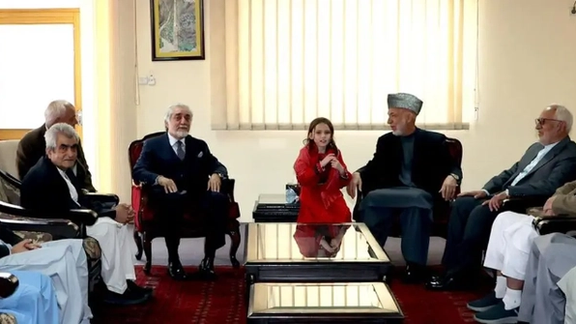Karzai’s Daughter Takes Centre Stage at Kabul Meet, a Symbolic Gesture Amid Restrictions

Abdullah Abdullah, former head of Afghanistan’s High Peace Council, has shared photographs from a recent meeting with former President Hamid Karzai.

Abdullah Abdullah, former head of Afghanistan’s High Peace Council, has shared photographs from a recent meeting with former President Hamid Karzai.
The images notably feature Karzai’s young daughter, Durkhani, seated prominently among male leaders and former officials, drawing widespread public interest and social media reactions. With the Taliban’s stringent restrictions on women and girls in public life, some observers have interpreted her presence as a “symbolic act of protest.”
In a post on social media, Abdullah shared two photos from the meeting, which took place on Saturday afternoon (27th October) at Karzai’s office in Kabul. He did not elaborate on the discussion’s topics or the significance of Karzai’s daughter’s presence.
The first image, taken inside Karzai’s office, shows Durkhani seated at the head of the gathering between Karzai and Abdullah, with other close associates of Karzai present. In the second image, taken in the office courtyard, she stands among the former leaders, her shawl draped over her shoulder.
Both Abdullah and Karzai, prominent political figures, remained in Kabul following the Taliban’s takeover and continue to meet occasionally. In light of the Taliban’s restrictive policies, which have barred girls from education beyond sixth grade and largely excluded women from public life, the presence of Karzai’s young daughter at the meeting has stirred considerable reaction on social media.
Activists suggest that this gesture could be seen as “symbolic and defiant,” given the Taliban’s views that limit the presence and voices of women and girls in public spaces. Karzai has previously engaged with women’s rights activists and has openly called on the Taliban to reopen schools and universities for girls.
Sources familiar with the matter revealed that Durkhani attends the Afghan-Turk school in Kabul, currently in her second year of primary education. Taliban policies have led to the closure of all secondary schools and universities for girls, effectively barring them from formal education beyond primary school. These restrictions have placed significant psychological and social pressures on Afghan women, with recent reports highlighting rising cases of suicide, forced marriages, and gender-based violence.